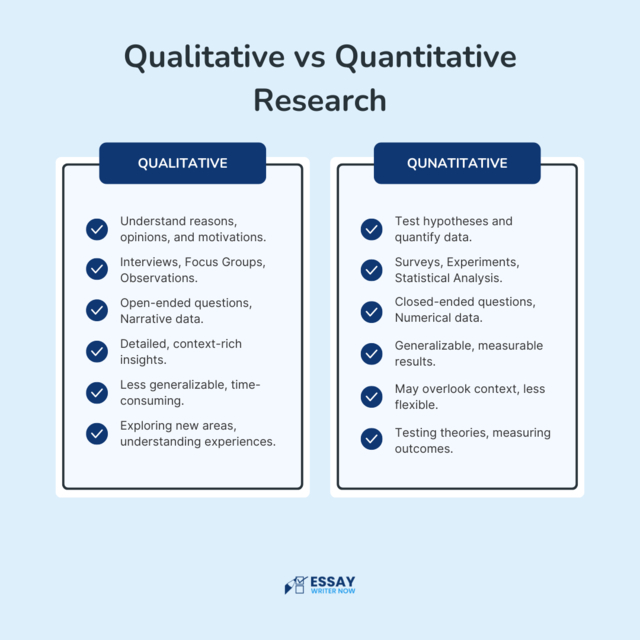What is Qualitative Research?
Qualitative research is a type of study that tries to understand problems and phenomena better. This kind of qualitative data can't be measured, but it relies on input from people who share their thoughts, opinions, or experiences with researchers.
You can also use qualitative research as a common way to collect data for a research paper written about subjects like humanities, history, and social sciences. This type of research can be used in any field where understanding human behavior is important. It involves gathering data that is not just numerical.
To understand what people are thinking and how they express themselves, it is important to capture it through interviews or observations.
Characteristics of Qualitative Research
Qualitative research is characterized by several distinct features that distinguish it from quantitative research. These characteristics underscore the nature of qualitative research as a methodological approach focused on understanding the depth, context, and subjective experiences of individuals and groups.
Here are the key characteristics of qualitative research:
Exploration of Complex Phenomena
Qualitative research aims to explore and understand complex phenomena within their natural settings. It discusses the intricacies of human behavior, attitudes, perceptions, and interactions.
Significance: This characteristic allows researchers to uncover underlying meanings, social contexts, and cultural differences that quantitative methods might overlook. It is particularly useful when studying topics where multiple variables interact in dynamic ways.
Subjectivity and Contextuality
Qualitative research acknowledges that knowledge and understanding are subjective and influenced by the context in which they occur. It values the perspectives and interpretations of participants.
Significance: By embracing subjectivity, qualitative research captures the lived experiences and unique viewpoints of individuals. It emphasizes understanding phenomena within their cultural, social, historical, and organizational contexts, providing a holistic view.
Flexible and Emergent Design
Qualitative research design is flexible and often emergent, adapting to new insights and changing research conditions. It allows researchers to adjust methods, questions, and focus based on emerging findings.
Significance: This characteristic enables researchers to explore unexpected themes, follow new leads, and go deeper into areas of interest that may arise during data collection. It fosters a dynamic approach to inquiry that is responsive to the complexity of human experiences.
In-depth Data Collection
Qualitative research emphasizes in-depth data collection methods such as interviews, focus groups, observations, and document analysis. These methods gather rich, detailed information.
Significance: By collecting detailed narratives, stories, and descriptions, qualitative research captures the depth and richness of human experiences. It provides a comprehensive understanding of behaviors, motivations, and social processes.
Emphasis on Participant Perspectives
Qualitative research values the perspectives, voices, and experiences of participants. It seeks to understand the world from their viewpoints and explore their meanings and interpretations.
Significance: This characteristic ensures that research findings are grounded in the realities of participants. It fosters empathy, respect, and ethical consideration for the individuals contributing their insights to the study.
Inductive Approach to Analysis
Qualitative research employs an inductive approach to data analysis, where themes, patterns, and categories emerge from the data itself rather than being predetermined.
Significance: This approach allows researchers to generate hypotheses, theories, and conceptual frameworks that are grounded in empirical data. It promotes a deeper understanding of the complexities of the research topic.
Contextual and Detailed Reporting
Qualitative research emphasizes contextual and detailed reporting of findings. It often includes rich descriptions, direct quotations, and thick descriptions to illustrate findings.
Significance: This characteristic enhances the transparency and credibility of qualitative research. It allows readers to understand the research context, interpret findings within their broader contexts, and assess the trustworthiness of the interpretations.
Holistic and Integrative Perspective
Qualitative research takes a holistic and integrative perspective, considering multiple sources of data, diverse viewpoints, and contextual factors.
Significance: This characteristic enables researchers to develop comprehensive understandings of complex phenomena. It encourages the integration of qualitative findings with other research methods or theoretical frameworks to enrich understanding and inform practice.
Qualitative Research Methodology
Qualitative methods are tricky to navigate, but they can be more reliable than quantitative research. It's important that you use multiple approaches when doing qualitative work. In order for your data collection process and analysis, conclusions are as robust as possible!
Here are the qualitative research methods that you'll frequently come across:
One-on-One Interviews
These involve in-depth conversations between a researcher and a participant. Through open-ended questions, researchers explore personal experiences, beliefs, and motivations. Face-to-face interviews allow for better understanding, observing non-verbal cues, and adapting questions based on responses.
Focus Groups
In focus groups, a moderator facilitates discussions among a small group of participants (typically 6-10). This method fosters interaction, allowing participants to express diverse viewpoints, debate ideas, and build upon each other's responses. It's effective for exploring shared perceptions, social norms, and group dynamics.
Ethnographic Studies
Ethnography involves immersing researchers in the natural environment of participants over an extended period. Researchers observe and participate in daily activities, rituals, and interactions to gain insights into cultural practices, societal norms, and community dynamics. This method emphasizes contextual understanding and the significance of culture in shaping behaviors.
Case Studies
Case studies discuss specific instances, events, or phenomena. Researchers gather detailed data through multiple sources such as interviews, observations, and document analysis. They analyze individual cases comprehensively to understand unique circumstances, contexts, and the interplay of factors influencing outcomes.
Record Keeping
Researchers use existing documents, records, and archival data to study historical trends, changes over time, or the evolution of practices. This method is valuable for exploring long-term patterns, societal shifts, and the impact of policies or interventions.
Observation
Observation involves systematically watching and recording behaviors, interactions, and settings in natural environments. Researchers use their senses to capture verbal and non-verbal cues, spatial arrangements, and environmental dynamics. It provides first hand insights into behaviors as they unfold in real-time.
Qualitative Research Questions
The goal of a qualitative research paper is to explore a topic in-depth by asking questions and getting answers from respondents. These can be called "exploratory" because they're designed for discovery, not just analysis or presentation purposes.
Following are the fundamental characteristics of qualitative questions:
- They are open-ended for free expression of opinions from the respondents.
- They include questions like “why” and “how”.
- The responses from such questions are difficult to quantify.
Here are some qualitative research questions examples:
- How do you cope with stress?
- How do you deal with gender intolerance at your workplace?
- What do you like the most about your job?
- Why did you choose to buy this certain trademark?
- Why did you invest your money in stocks?
Data Analysis in Qualitative Research
Once data is collected, qualitative researchers engage in rigorous analysis to uncover patterns, themes, and insights that address their research questions.
Here’s how you can do qualitative data analysis:
- Transcription: Recorded interviews or focus group sessions are transcribed verbatim, capturing spoken words and non-verbal cues.
- Coding: Researchers systematically categorize and label data segments (quotes, phrases, or paragraphs) based on recurring themes, ideas, or concepts. This process helps in organizing data and identifying patterns.
- Thematic Analysis: Involves identifying, analyzing, and reporting patterns or themes within the data. Researchers look for commonalities, differences, and relationships between themes to develop a deeper understanding of the phenomena being studied.
- Content Analysis: Focuses on analyzing the content of textual, visual, or audio data to identify specific meanings, patterns, and trends. It involves systematic coding and categorization to interpret the data and draw meaningful conclusions.
- Constant Comparison: Throughout the analysis process, researchers compare new data with previously coded data to refine categories, ensure consistency, and deepen understanding.
Advantages of Qualitative Data Analysis
Here are some advantages of using qualitative data analysis:
- Depth and Detail: Allows researchers to explore complex phenomena in depth, capturing the richness and intricacies of human experiences.
- Flexibility: Adapts to emergent themes and unexpected findings, allowing researchers to explore diverse perspectives and interpretations.
- Contextual Understanding: Emphasizes the context in which behaviors and experiences occur, providing insights into cultural, social, and environmental influences.
- Theory Development: Generates hypotheses and theoretical frameworks that explain observed behaviors and phenomena, contributing to broader theoretical advancements.
Qualitative Vs Quantitative Research
Here is a brief comparison of qualitative and quantitative research:

Benefits of Qualitative Research
Here are some key advantages of conducting qualitative research:
In-depth Understanding
Qualitative research allows researchers to discuss the subject matter comprehensively. It focuses on exploring phenomena in their natural settings, which helps in capturing the complexities of human experience that quantitative methods may overlook.
Rich Data
This method gathers rich, detailed data through techniques like interviews, focus groups, and observations. Such data provide insights into participants' perspectives, emotions, and cultural contexts, offering a holistic view of the topic under study.
Flexibility
Qualitative research is flexible, allowing researchers to adapt their approach based on emerging findings. It enables exploration of unexpected themes or issues that arise during data collection, leading to a more comprehensive understanding of the research problem.
Contextual Understanding
It emphasizes understanding phenomena within their specific contexts. This contextualization is crucial for interpreting behaviors and decision-making processes influenced by cultural, social, and organizational factors.
Theory Generation
Qualitative research often contributes to theory generation by uncovering new concepts, relationships, or frameworks. It can help develop hypotheses that can be tested further through quantitative research, contributing to the overall advancement of knowledge.
Participant Perspectives
This method prioritizes participants' voices and perspectives, providing them a platform to express their views in their own words. This approach fosters authenticity and can reveal insights that quantitative surveys might not capture.
Exploration of Complex Issues
It is particularly useful for exploring complex issues or topics where quantitative methods might struggle to capture the depth and intricacy of human experiences, behaviors, and interactions.
Practical Applications
Qualitative research findings can have practical applications in fields such as sociology, psychology, anthropology, marketing, and healthcare. They can inform policies, interventions, and practices that are more closely aligned with the needs and realities of the people involved.
Complementarity with Quantitative Methods
When used in conjunction with quantitative research, qualitative methods can provide a more comprehensive understanding of a research problem. They can help explain quantitative results, explore outliers, or generate hypotheses for further investigation.
Limitations of Qualitative Research
Qualitative research, while valuable and insightful, does come with several limitations that researchers need to consider:
Subjectivity and Bias
One of the primary concerns with qualitative research is the potential for researcher bias to influence the interpretation of data. Since qualitative methods often rely on the researcher's judgment and interpretation, there is a risk that personal biases or preconceived notions could shape the findings.
Limited Generalizability
Qualitative studies typically involve small sample sizes and are often context-specific. As a result, findings from qualitative research may not be easily generalizable to larger populations or different settings. The focus is often on depth rather than breadth.
Difficulty in Replication
Due to the contextual and subjective nature of qualitative research, replicating findings exactly can be challenging. Different researchers approaching the same topic might reach different conclusions based on their interpretations.
Time and Resource Intensiveness
Qualitative research can be time-consuming and resource-intensive. Data collection and analysis involve detailed observation, interviews, and often lengthy transcripts that require careful scrutiny. This can limit the scale of qualitative studies compared to quantitative research.
Limited Quantification
Qualitative data is descriptive and narrative in nature, which makes it difficult to quantify. This can pose challenges when attempting to analyze trends or patterns in a systematic and statistically meaningful way.
Potential for Misinterpretation
Without careful attention to methodology and analysis, qualitative findings can be misinterpreted or misused. Ensuring rigor and transparency in qualitative research is essential to mitigate this risk.
Difficulty in Data Analysis
Analyzing qualitative data requires specialized skills and expertise. Techniques such as thematic analysis or grounded theory are used to derive meaning from the data, but these can be complex and subjective processes.
Qualitative Research Examples
Here are some examples to help you understand how to do your own qualitative research.
Qualitative Research Topics
Here are some topics to think about for your qualitative research paper:
- The Increasing Gender Identity Issues in Our Society Today
- Purchaser Behavior Changes During COVID-19
- Research Study on Men Who Commit Rape are More Likely to Use Violence in Their Relationships With Women
- Effects of Gender Discrimination in Workplaces
- The Link Between Mental Stability and Being Overweight
- Conditions and final products of Drug Abuse in Teens Today
- Advantages and Disadvantages of Remote Learning on Students
- The Effect of Depression on Our Physical Health
- Focusing on the Motive Behind the Increasing #MeToo Movements Today
- The Impact of Divorce or Separation of Parents on Development of Children
In conclusion, qualitative research is an important way to get a deep understanding of what people are feeling and thinking. This type of inquiry seeks out information from interviews, observations, or other forms that provide insight into the experiences they've had in their lives.
We have given you an overview of qualitative research in this blog post. Qualitative research is a type of research where you study people's thoughts and feelings. We have told you if it is the right approach for your project or not. We hope this information has been helpful.












